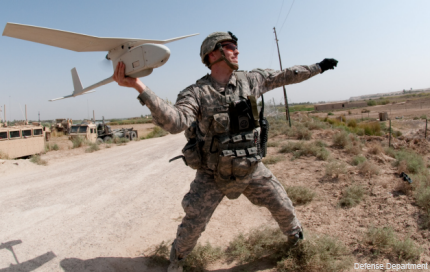Army to put high-quality radar into smaller drones
A $99 million contract for small synthetic aperture radars expands the options for radar-equipped UAVs.

Some of the systems the Army is buying could be used in UAVs as small as the hand-launched RQ-11 Raven.
The Army recently awarded a nearly $99 million contract for small synthetic aperture radars (SAR) systems, in a move that continues a trend toward adding radar capabilities to smaller unmanned aerial vehicles.
ImSAR LLC was awarded the five-year deal for research, development, rapid advancement and integration of SAR systems by the Army Contracting Command, according to a Defense Department announcement.
As the military expands its use of unmanned systems, the technology aboard those systems is becoming more sophisticated. And that includes, smaller, lighter and even more accurate radar systems.
Synthetic aperture radar combines propagated radar signals and complex digital processing to create high-resolution images of landscapes or other objects, and can operate in virtually any weather conditions. It can be used, for instance, to identify the structural elements of terrain or the extent of an oil spill at sea, according to Sandia National Laboratories.
In the military, along with obvious tasks such as mapping out terrain or spotting enemy vehicles and personnel, it can also be used to identify improvised explosive devices. A team from the Counter IED Branch at Hanscom Air Force Base, Mass., recently won an award for developing and deploying what the Air Force said is the world’s smallest SAR system. One of its uses is IED detection, according to the Air Force.
The Hanscom team fitted two SAR systems—a lightweight Ku band SAR and an ultra-wide band, ultra-high frequency SAR—each onto four RQ-7 Shadow UAVs. Combined with a miniature munitions system (called the Terminator), it allows the UAVs to detect and engage IEDs and enemy forces while being operated from a distance.
The Army, meanwhile, has been actively acquiring SAR systems. In April, the Contracting Command awarded Northrop Grumman a $40.7 million contract for up to 94 lightweight systems known as STARLite. Those systems, intended for likely use in the long-range MQ-1C Gray Eagle UAV and the Persistent Threat Detection System aerostat, weigh 65 pounds each. With ImSAR, the Army is going for smaller systems, and use in smaller UAVs—the Army also awarded the company a $24 million contract for SAR systems in 2012.
ImSAR currently offers two SAR systems. The NanoSAR B measures 6.2 by 7.2 by 4.5 inches, weighs 3.5 pounds and consumes less than 30 Watts of power. The NanoSAR C, at 5.5 by 3.5 by 2 inches, weighs 2.6 pounds and consumes less than 25 Watts, according to the company. They both transmit at 1 Watt and both can be mounted on a 7-inch wing-mounted pod or in the fuselage of an aircraft.
The NanoSAR B is suitable for Tier II UAVs; the NanoSAR C for Tier I or II, according to the company. In the Army’s classifications, Tier I covers small UAVs such as the hand-launched RQ-11 Raven. Tier II covers short-range tactical UAVs such as the RQ-7 Shadow.
And the size of radars system, whether high-resolution SAR or otherwise, could continue to shrink. An Alaskan company, Integrated Robotics Imaging Systems, and researchers from the University of Denver recently developed a 12.5-ounce collision avoidance radar system in an effort to meet Federal Aviation Administration requirements for domestic drone use.
NEXT STORY: Army's air defense simulator gets a big upgrade




